Wheatcroft R18 car-by-car histories
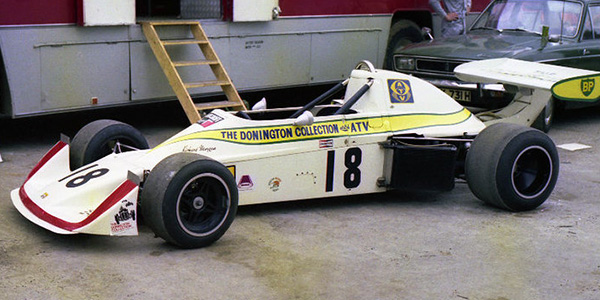
Richard Morgan's Wheatcroft R18 in July or August 1975. Copyright Michael C. Brown 2010. Used with permission.
Designed by Mike Pilbeam for Tom Wheatcroft, the Wheatcroft R18 ran in F2 and Formula Atlantic in 1975, and proved a success in both. Two cars ran for many years in South Africa and a third raced in British F3 for several years.
After the death of his protégé Roger Williamson in 1973, Tom Wheatcroft returned to motor racing in 1975 with a Formula Atlantic project. The team would start the season with a Chevron B29 but he also commissioned freelance designer Mike Pilbeam, who had just left BRM to set up his own company, to design a completely new car to carry the Wheatcroft name. The driver chosen was Richard Morgan, the younger brother of David Morgan who had been very competitive in Formula Atlantic in 1974. Richard had dominated Formula Ford in Britain in 1974 with a Crosslé 25F and was quickly to the fore in his Wheatcroft Racing Chevron B29 at the start of the 1975 Formula Atlantic season. He won his second race, at Mallory Park, but some momentum was lost after an accident at Silverstone in April. The new Wheatcroft R18 was ready for the Brands Hatch race on 18 May. It had only been tested for a day at Snetterton but Morgan already felt that it was a better car than the Chevron. The R18 was a very compact car with all the fuel contained in a single fuel cell behind the driver and a rear wing support that housed the battery and spark box. The front suspension used a pullrod design that drew on Pilbeam's experience working on the Lotus 72, and the complete car was reported to be 150 pounds lighter than the Chevron. Morgan was second fastest in practice, behind the works Modus of Tony Brise, and gave the Wheatcroft marque the perfect start by leading the first lap, although he was to retire on that occasion. After Brian Henton wrote off the first car at Oulton Park in testing, Morgan continued the R18's promising start by leading from start to finish at Snetterton on 29 June and setting a new outright lap record. He won again at Brands Hatch two weeks later - again leading every lap! Although the R18's success was tempered in the next few races, Wheatcroft decided to convert the car to F2 specification for the race at Silverstone at the end of August, and recruited Henton to drive. It was fitted with extra tanks, the regulation deformable structures, a 2-litre Hart BDA, and 50 pounds of lead ballast to bring it up the minimum weight. Henton qualified in a magnificent third place and then led from the start, as the little R18 was prone to do. The lead only lasted a lap, but Tom Wheatcroft was delighted. Henton eventually finished third and was given the Formula Atlantic drive for the rest of the season; poor Morgan being dropped. Wheatcroft and Pilbeam soon started work on an ambitious F2 project for 1976, the Wheatcroft R26.
If you can add to our understanding of these cars, or have photographs that we can use, please email Allen at allen@oldracingcars.com.
New to Wheatcroft Racing for Richard Morgan to race in British Formula Atlantic in 1975. When the car first appeared, at Brands Hatch on 18 May, Morgan was second fastest in practice behind the dominant Modus M3 of Tony Brise, and led the opening lap. Brise took the lead on lap 2, after which the Wheatcroft's engine started to misfire, dropping Morgan further back. He eventually retired with a broken splitter. Brian Henton, then a F2 driver tipped to rise to F1, was brought in to test the car but crashed in testing at Oulton Park the following Wednesday, writing off the car.
Driven by: Richard Morgan and Brian Henton. First race: Brands Hatch (R2), 18 May 1975. Only one recorded race.
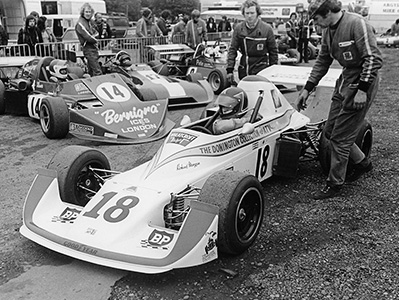
Richard Morgan in the Wheatcroft R18 at Brands Hatch in July 1975. Copyright Ted Walker 2019. Used with permission.
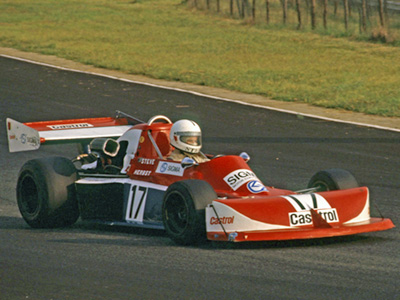
Steve Herbst in his March-nosed Wheatcroft R18 at Kyalami in 1982. Copyright David Pearson (motoprint.co.za) 2024. Used with permission.
New for Wheatcroft Racing in June 1975, replacing chassis 001 which had been destroyed by Brian Henton while testing at Oulton Park in late May. Raced by Richard Morgan in British Formula Atlantic in Donington Park Collection livery. In August the car was converted to F2 spec and driven by Henton at the Silverstone F2 race, finishing third. Henton then drove it in Formula Atlantic for the rest of the season. Sold to Alex Blignaut for Nols Nieman to drive in the 1976 South African Formula Atlantic series as a spare car to his new chassis 003. Retained for 1977 and 1978, but apparently not raced over these two seasons. Sold to Steve Herbst in 1979, and converted to a Mazda engine for Formula SA. In early 1980, Herbst was involved in a collision with Peter Morrison in the sister R18. Herbst's car's tub was repaired by Mike Domingo, and Herbst continued to race it until mid-1982. In August 1982, it was sold to Trevor Trautmann, again for Formula SA, and in 1983 he had a new monocoque fabricated in South Africa for the car, the original tub apparently being discarded. He did not complete the rebuild and later sold the car's gearbox, suspension and uprights to Dorino Trocchani for a Tiga sports racing car project. The new tub and bodywork were sold off, but quickly located by Roger Pearce and sold to John Hatfield (Pinetown, Kwazulu-Natal), who owned the sister R18-003. Hatfield built up a car on the new tub using parts from both 002 and 003, but using the 002 chassis plate. The resulting car was exported to the UK some time between 1987 and 1993, and in 1996 it was purchased from a dealer in Cheshire by Paul Gardener of Bolton. He noted that it still had the 002 chassis plate. In 2004, Simon Hadfield collected the Wheatcroft from Gardener and delivered it to Mondello for Martin Birrane. It remained in Birrane's collection until about 2016.
Driven by: Richard Morgan, Brian Henton, Nols Nieman and Steve Herbst. First race: Snetterton (R9), 29 Jun 1975. Total of 13 recorded races.
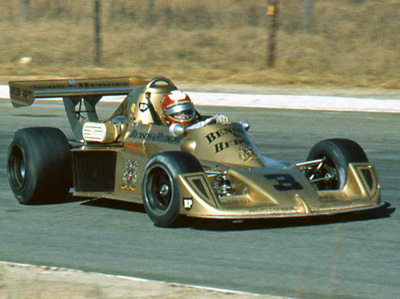
Nols Nieman in Alex Blignaut's Wheatcroft R18 at Kyalami in 1976. Copyright David Pearson (motoprint.co.za) 2024. Used with permission.
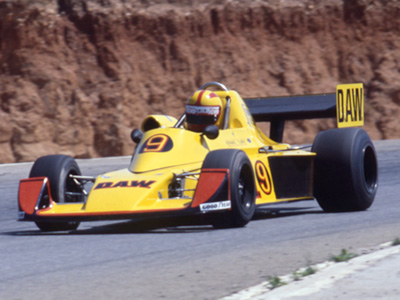
Bernard Tilanus in the DAW Wheatcroft R18 at Kyalami in 1978. Copyright David Pearson (motoprint.co.za) 2024. Used with permission.
New to Alex Blignaut for Nols Nieman to drive in the 1976 South African Formula Atlantic series, sponsored by Benson & Hedges. The team had the older R18/002 as a spare car. Retained for 1977, when it was also driven by Royce Love and Grant Maben. Retained again for 1978, when it was probably the car raced by Keith Zeeman for Blignaut's team. Sold to Jeff Waberski's DAW Supplies team for Bernard Tilanus to drive from October 1978 onwards. When the new Formula SA rules were introduced, the R18 was the first chassis to be fitted with a Mazda engine. Driven by Peter Morrison in early 1980, but Tilanus took over the car again after his newer March 78B was destroyed. Later in 1980, Tilanus swapped the car for Soon Weeks' March, and Weeks continued with the Wheatcroft in 1981. Weeks is believed to have had an accident in the car, after which he kept it until 1986 when he sold it to Dave Hart in Natal, complete with the same BMW M10 engine that Hart had used in his March 77B back in 1979. The car then passed to John Hatfield (Pinetown, Kwazulu-Natal) who was looking for a Hewland FT200 for his Chevron B61 and an engine for a Chevron B8. Around 1990 Hatfield also acquired the remains of R18-002 from Trevor Trautmann (via Roger Pearce). Trautmann had had a new monocoque for the car fabricated locally in 1983. Hatfield then consolidated the remains of both cars into the new monocoque, fitted the chassis plate from 002 and restored it to rolling chassis condition. The subsequent history of the 003 monocoque and parts is unknown. It was last seen leaning against a wall at Hatfield's Status Cars workshop in Pietermaritzburg, KwaZulu-Natal. However, in June 1993, Alan Goodman (Reading) drove a Wheatcroft R18, reportedly chassis 003, in a Historic F3 race at Thruxton.
Driven by: Nols Nieman, Royce Love, Grant Maben, Keith Zeeman, Bernard Tilanus, Peter Morrison, Soon Weeks and Dave Hart. First race: Killarney (R1), 24 Jan 1976. Total of 34 recorded races.
New to John Bright (Leicester) and built up with a Toyota Novamotor engine for British F3 in 1977. In early July, Bright spent a day testing at Silverstone with Brian Henton and Mike Pilbeam, and the following Friday he won from pole in a non-championship race at Donington Park. Unfortunately, two days later during practice at Cadwell Park he put a wheel into the gravel going into the Gooseneck curves and crashed very heavily. The car was described as being "completely destroyed". He returned at Donington Park three weeks later with the car described as "rebuilt", but it seems very likely that this was the point at which the car was rebuilt on the 006 chassis, so its history is continued under that heading.
Driven by: John Bright. First race: Silverstone (R1), 6 Mar 1977. Total of 9 recorded races.
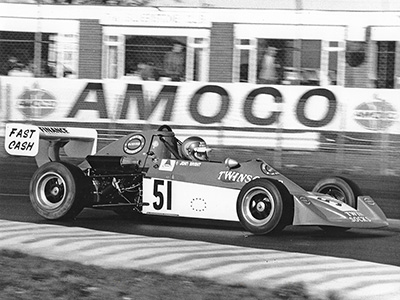
John Bright in his Wheatcroft R18 at the 1978 International Trophy. Copyright Ted Walker 2019. Used with permission.
Chassis 006 is believed to be the identity of the rebuilt car raced by John Bright (Leicester) in British Formula 3 following his massive accident at Cadwell Park in July 1977. Bright first drove the "rebuilt" car at Donington Park on the last day of July, and continued with it to the end of that season. He raced it again in 1978, but again crashed, at Brands Hatch in July, and this time the car did not reappear. Bright sold the R18 to Rhoddy Harvey-Bailey (Hilton, Derbyshire) and John Colley for 1979, and as part of the deal Bright rebuilt it to Formula Atlantic specification. It was raced by Harvey-Bailey, Colley and Ian Shaw, using Alan Smith BDA engines. It was also raced on one occasion by John Bright. It was advertised by Roger Cowman in September 1979 as "hardly used". Colley sold it to hillclimber Richard Barnes (Lichfield, Staffordshire), who fitted an 1100cc Cosworth BDJ and hillclimbed it for a while. He has retained the car in his collection since then.
Driven by: John Bright, Rhoddy Harvey Bailey, Ian Shaw and John Colley. First race: Donington Park (R5), 31 Jul 1977. Total of 21 recorded races.
Alex Blignaut ordered a new Wheatcroft R18, chassis 003, for the new South African Formula Atlantic championship in 1976, and also bought the ex-Morgan/Henton chassis 002 as a spare car. Other tubs had been completed and chassis 004 was given to John Bright so he could build it into a Formula 3 car. By the end of his time with it, after multiple accidents, it had become chassis 006, and this car was rebuilt as a Formula Atlantic for 1979. That same season, the two cars in South Africa, 002 and 003, were fitted with Mazda engines for Formula SA where they proved highly effective.
Acknowledgements
Thanks to Ian Hebblethwaite for information on the two cars in South Africa, to John Colley and Richard Barnes for the history of 006, to John again and to Ted Walker for the use of their photographs, and to Steve Wilkinson and Simon Hadfield for their help.
If you can add to our understanding of these cars, or have photographs that we can use, please email Allen at allen@oldracingcars.com.
These histories last updated on .